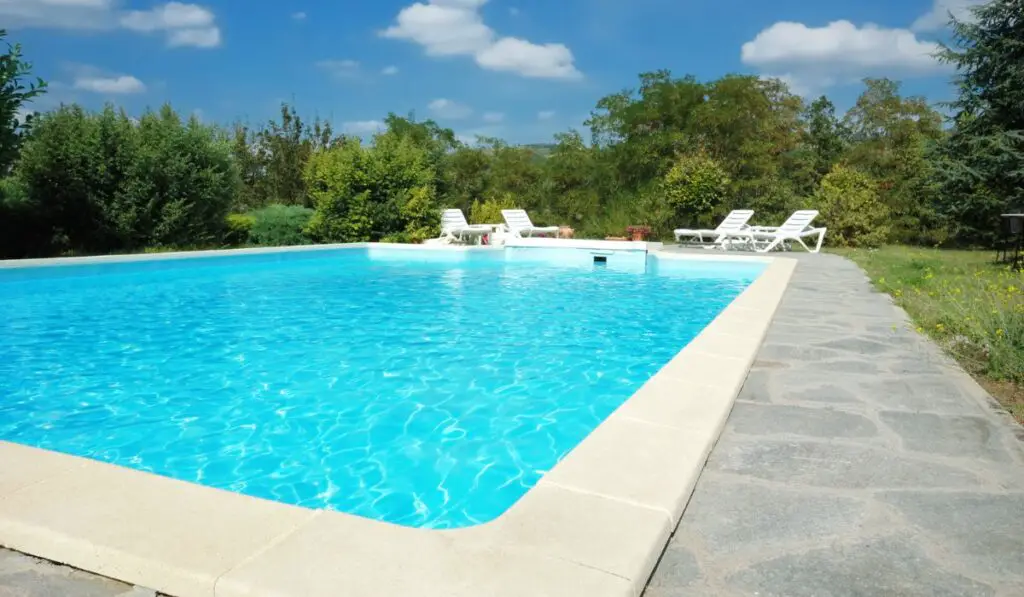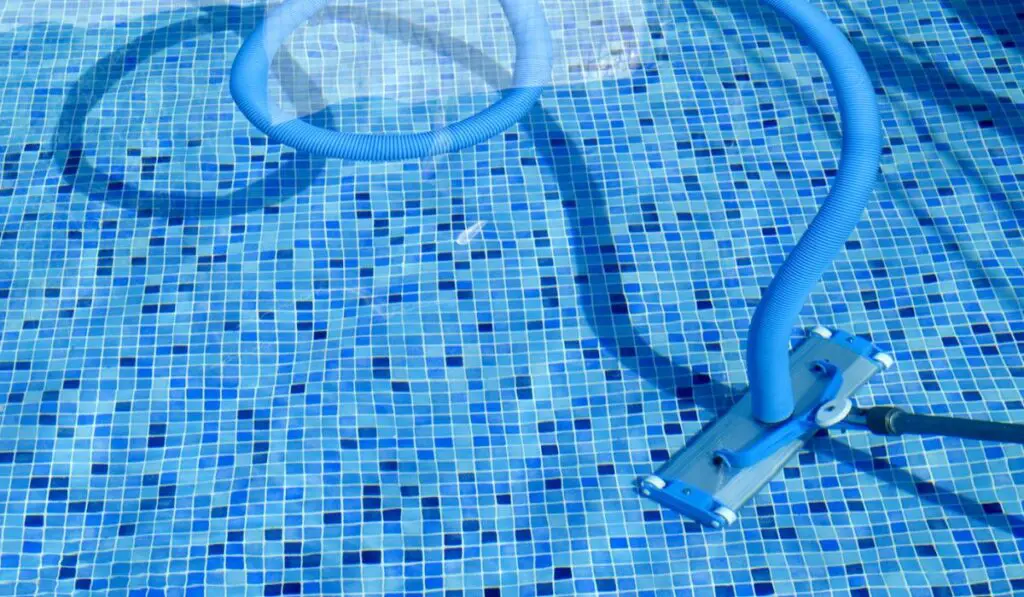There’s nothing like stepping into your backyard and jumping into sparkling, clear water. The experience is definitely not as rejuvenating if you find yourself stepping on gritty sand the entire time, though. But unless you have an extremely sandy backyard or have just visited the beach, the list of the possible causes behind a sandy pool is thankfully short.
You might have sand in your pool because of a particularly windy day or a broken sand filter. The problem may also be mustard algae, which can be mistaken for sand. You can remove sand from your pool by vacuuming the water. If mustard algae are the culprit, you can remove it by shocking the pool.
Sand in the water doesn’t mean that your pool is going to turn into a pit of quicksand. However, it’s still important to get rid of it as soon as possible. Let’s look at why there might be sand in your pool and how you can remove it, so you don’t have to swim in gritty and grimy water again.
Reasons Why There Is Sand In Your Pool

Before you start working on removing the sand from your pool, it’s important to determine the cause of the problem first. There are three main reasons why there might be sand in your pool:
Windy Weather
It’s highly likely that the sand that’s settled on your pool floor simply fell into the water. This is possible even if you don’t have a particularly sandy backyard, as wind can pick up and carry sand particles over long distances.
However, if there’s a lot of sand on the pool floor, then this may not be the reason behind your gritty pool.
Broken or Faulty Sand Filter
The most likely reason behind a sandy pool is a faulty or broken component in your sand filter. Even if the filter seems to be working normally, the inner components might be damaged or cracked because of overuse or age. This could then result in the sand being pumped back into the pool with the filtered water.
Mustard Algae
The “sand” on your pool floor might not actually be sand at all. In fact, it could be mustard or yellow algae, which looks a lot like sand when left undisturbed.
You can easily determine whether it’s sand or algae by swirling the water near the “sand” with a pool brush. If a cloud starts to form, then you have mustard algae. Luckily, this problem is also pretty easy to fix with the right amount of algaecide. It will only take you a few hours to set your pool back to its crystal clear state again.
How Do I Know If My Sand Filter Is Broken?
If the sand in your pool is because of a broken sand filter, then it’s highly likely that you’ll need to replace the filter’s laterals or standpipe. And unless you’re a professional pool technician, you probably don’t know where these components are in your filter system.
So, let’s look at what these pieces actually are and where things might have gone wrong.
Standpipe
A standpipe is located at the center of the sand and connected to the filter’s multiport valve at the top. The bottom of the pipe is connected to the laterals.
If the standpipe breaks at any point due to damage to the filter or just normal wear and tear, then you’ll end up with a pile of sand in your pool water.
Laterals
In a sand filter, water first passes through the sand in the tank. Pool water enters the filter from the top and as it makes its way down, the sand filters out all the small contaminants and debris from it.
Once this filtered water reaches the bottom of your sand filter, the return jets push it back out into the pool. Of course, you want your filter to only push out the water and none of the sand present in the tank.
To ensure this happens, sand filters are designed with a simple array of eight to 10 laterals, which basically function as a sieve. Each lateral has tiny holes that allow the filtered water to pass through, but not the sand.
If the laterals are cracked or damaged, then the sand will simply pass through and enter your pool with the filtered water.
How To Fix or Replace a Sand Filter
If you’ve found that any of the parts of your sand filter are broken or cracked, then it’s important to fix or replace them before you remove the sand from your pool. It’s also a good idea to have a couple of replacement parts on hand, so you can quickly fix the filter if the same problem happens again.
If you already have an extra lateral or standpipe, then that’s great. But if you don’t, there’s no need to worry. Just make sure you order some before you start the fixing process.
Fixing a Broken Standpipe or Broken Laterals
In order to fix a cracked or broken component, it’s first important to open up the sand filter and determine exactly what’s broken. Once you’ve identified the problem, follow all the steps you normally would when changing the sand of the filter.
Then, replace the broken components, add sand until it’s back up to its normal level, and reassemble the entire filter. Now that you’ve fixed the main cause of the problem, you can start working on removing all the pesky sand from your pool.
How To Remove Sand From Your Pool

Because sand particles are heavier than water and sink to the bottom of the pool, you’ll only need a bit of elbow grease to remove sand from the pool. Here’s what you need to do:
- Push all the sand in your pool to one area with a pool brush (on Amazon).
- Turn your filter’s multiport valve to “Filter” and vacuum all the sand back into your filter.
- Vacuum the entire pool manually.
- Test the water with a liquid test kit (on Amazon) or test strips (also on Amazon), then add all the chemicals needed to balance it.
Mustard Algae
If your pool is not equipped with a sand filter, then you probably have mustard algae instead of sand in your pool. Keep in mind that while the wind can carry and drop sand in the pool water, it won’t drop a lot of it at one time.
Mustard algae usually attach themselves to pool equipment, walls, and other items, and can actually survive outside the swimming pool. It can piggyback on floats, toys, and even bathing suits, so it’s best to always have disinfectant handy.
How To Remove Mustard Algae From Your Pool
If you see mustard algae in your pool, there’s no need to worry. The problem is extremely easy to fix and you just need to take a couple of simple steps to return your pool back to its balanced state again. Here are a few things you can do:
Machine Wash All Your Bathing Suits
Giving all your bathing suits a spin in the washing machine will help kill all the mustard algae clinging to the fabric. It’s also advisable to use color-safe (or even regular) bleach for additional peace of mind.
Clean the Pool Toys and Floats
Use a chlorine-based cleaner and a cloth to thoroughly clean all your pool toys, floats, and other accessories. Try to avoid using full-strength bleach, as it could damage the rubber and plastic items. Instead, it’s best to opt for a multipurpose cleaner that will get rid of all the mustard algae without destroying any of your possessions.
However, if you only have bleach on hand, then make sure you dilute it with water in a 1:10 ratio before using it to wipe down any surfaces.
Place All Your Pool Equipment at the Shallow End
It’s advisable to move all your pool maintenance equipment, including the poles and hoses, to the shallow end of your pool. This will make it easier to disinfect and sanitize everything when you shock the pool.
Vacuum Out All the Mustard Algae
Make sure you loosen out all the algae with an algae brush and then vacuum it out with a specialized pool vacuum (on Amazon). It’s best to manually vacuum your pool, so you can remove as much of the algae as possible. Lastly, refill the pool to replace all the water you lost in vacuuming.

Хотите найти информацию о человеке ? Наш сервис поможет полный профиль мгновенно.
Используйте продвинутые инструменты для анализа публичных записей в открытых источниках.
Выясните место работы или активность через автоматизированный скан с гарантией точности .
глаз бога бот
Система функционирует с соблюдением GDPR, обрабатывая общедоступную информацию.
Получите расширенный отчет с геолокационными метками и списком связей.
Попробуйте надежному помощнику для digital-расследований — результаты вас удивят !